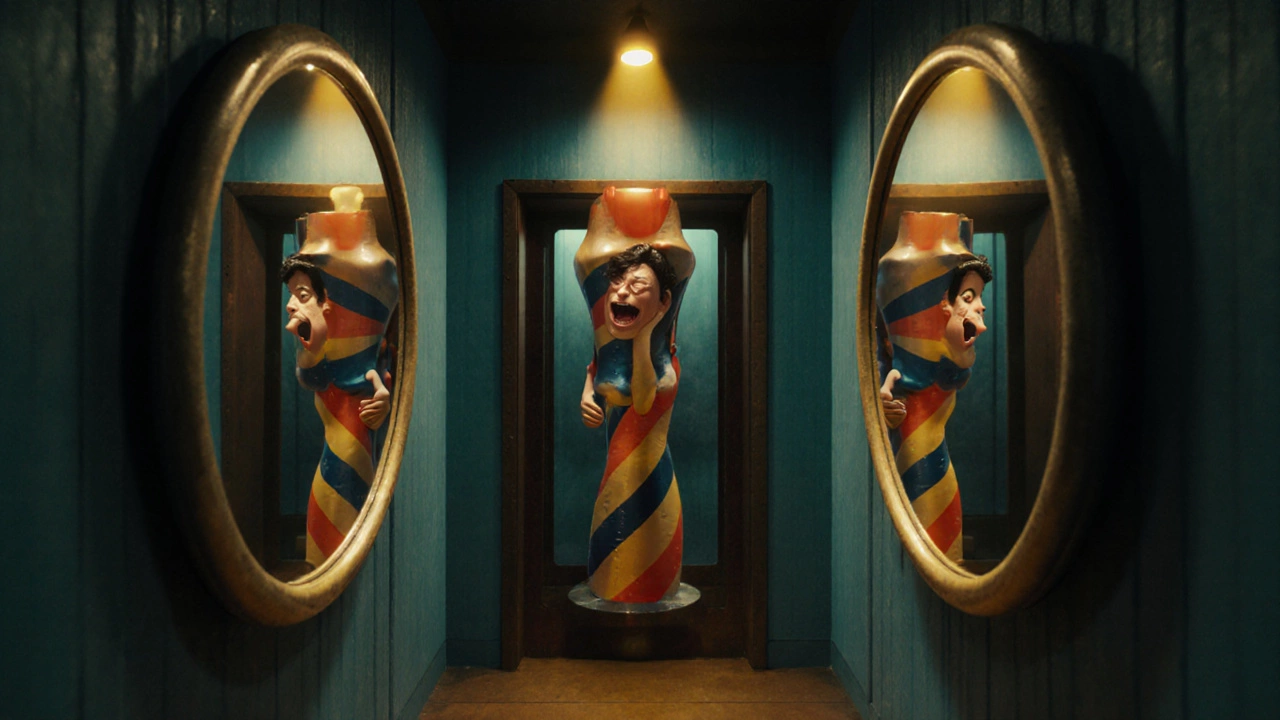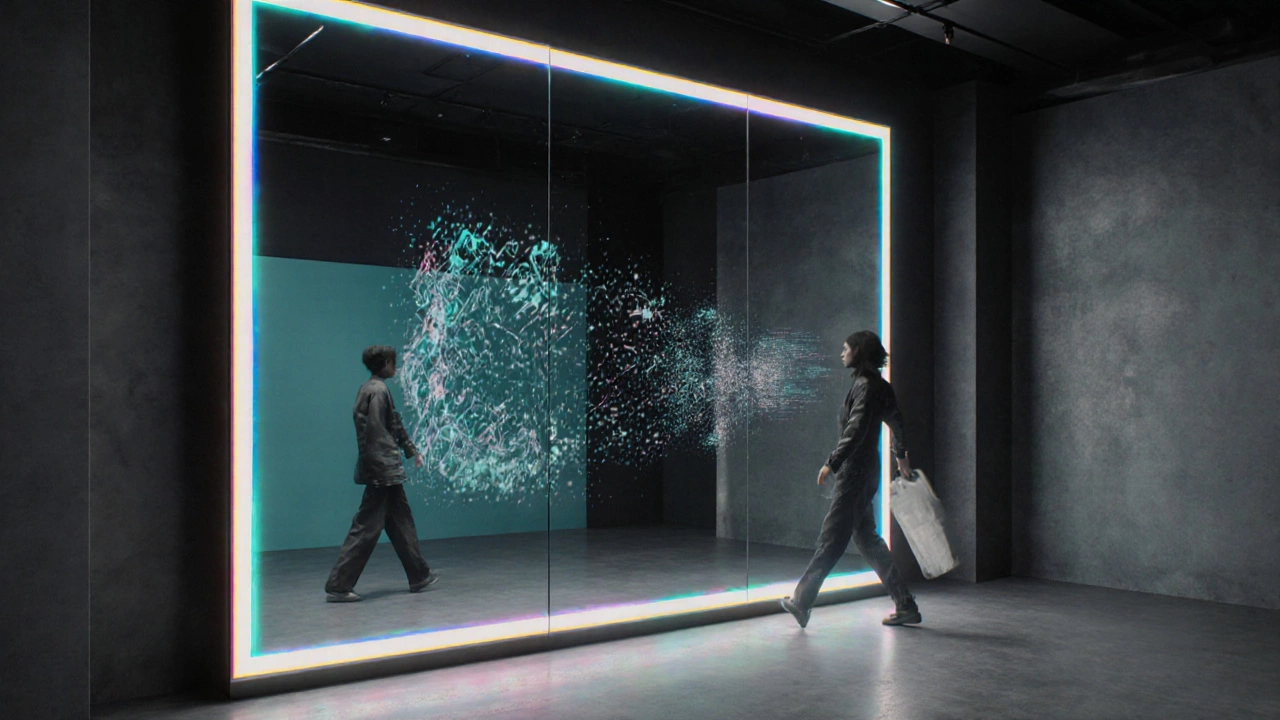What Is a Trick Mirror? Types, History, Uses and Buying Guide
 Oct, 18 2025
Oct, 18 2025
Trick Mirror Selector Tool
Choose Your Mirror Type
Recommended Mirror Type
Why this type?
Installation Tips
Ever walked into a hallway and seen yourself stretched, shrunk, or multiplied like a kaleidoscope? That odd, eye‑tricking effect comes from a trick mirror. These mirrors are engineered to play with reflection, creating visual surprises that range from playful funhouse distortions to eerie infinite corridors. Below we break down exactly what a trick mirror is, how it works, the main styles you can buy, and where to put one for maximum wow factor.
What Is a Trick Mirror?
Trick mirror is a type of reflective surface designed to alter the way light bounces back, producing distorted or multiplied images. Unlike a standard flat mirror, a trick mirror manipulates the geometry of its surface-curving, splitting, or layering glass to create optical illusions. The result can be a stretched silhouette, a compressed figure, or an endless tunnel of reflections.
Brief History: From Ancient Screens to Modern Funhouses
The idea of bending reflections isn’t new. Ancient Romans used polished metal plates to create simple magnifying effects, while Chinese scholars experimented with convex lenses for entertaining court spectacles. The modern incarnation, however, traces its roots to 19th‑century amusement parks. Funhouse mirror booths became a staple of fairs, offering visitors a chance to see themselves in comical, warped shapes. By the 1960s, designers introduced the Infinity mirror, a series of mirrored panes and LED lights that generate a visual tunnel extending into an illusion of endless space. Today, trick mirrors appear in boutique home décor, retail displays, and themed entertainment venues worldwide.
Core Types of Trick Mirrors
Not all trick mirrors are created equal. The main categories differ in shape, effect, and typical applications.
| Mirror Type | Surface Shape | Typical Visual Effect | Common Use Cases |
|---|---|---|---|
| Convex | Outward‑curved | Reduced size, wider field of view | Security mirrors, store aisles |
| Concave | Inward‑curved | Magnified image, focal point | Makeup stations, scientific demos |
| Funhouse | Irregular curvature (cylindrical, cylindrical‑plus) | Exaggerated stretch or compression | Amusement parks, party venues |
| Infinity | Two parallel reflective panes | Repeating tunnel of lights | Home décor, night‑clubs |
| Two‑Way | Partially reflective glass | One‑way view, privacy | Observation rooms, retail fits |
How Do Trick Mirrors Work? The Optics Behind the Illusion
All trick mirrors rely on basic principles of optical illusion: light rays strike a surface and bounce off at angles determined by the surface’s curvature. In a flat mirror, the angle of incidence equals the angle of reflection, preserving the image’s size and orientation. Curve the surface, and you change those angles, warping the reflected image. Convex mirrors diverge light, making objects appear smaller and farther away. Concave mirrors converge light, causing magnification when the object is within the focal length. Funhouse mirrors combine multiple curvatures-sometimes cylindrical in one direction and convex in another-to stretch the body on one axis and compress it on the other.
The infinity mirror uses a different trick: a semi‑transparent mirror paired with a fully reflective one, plus LEDs placed between them. Light bounces back and forth hundreds of times, each bounce creating a faint duplicate, which our eyes blend into a continuous tunnel.

Where Can You Use a Trick Mirror?
Beyond amusement parks, trick mirrors are gaining popularity in interior design and retail.
- Home décor: An infinity mirror serves as a modern art piece, adding depth to a living‑room wall.
- Retail displays: Convex mirrors let store owners monitor aisles, while two‑way mirrors can create private fitting rooms that still let staff see inside.
- Event venues: Funhouse mirrors become instant photo‑booth attractions at weddings or festivals.
- Wellness spaces: Concave mirrors are used in yoga studios to provide gentle self‑observation without harsh distortion.
Buying Guide: Choosing the Right Trick Mirror for Your Space
When shopping for a trick mirror, consider these factors.
- Purpose: Decide if you want a decorative piece (infinity), a safety tool (convex), or a playful attraction (funhouse).
- Size & Placement: Measure wall space. Larger mirrors (over 4 ft) work best as focal points; smaller ones can be handheld or wall‑mounted near entryways.
- Material: Look for tempered glass for durability, especially in public areas. Acrylic alternatives are lighter but can scratch.
- Safety: Ensure the mirror meets local safety standards (e.g., ASTM C1048 for tempered glass). Edge polishing reduces injury risk.
- Lighting: Infinity mirrors need LED strips; choose color‑changing LEDs for mood lighting.
- Mounting hardware: Heavy mirrors require wall anchors or a professional installer.
Brands such as MiroLux and FunHouseFX offer pre‑finished kits with mounting brackets, making DIY installation straightforward.
Care and Maintenance Tips
Keeping a trick mirror sparkling ensures the illusion stays convincing.
- Cleaning: Use a microfiber cloth and a gentle glass cleaner. Avoid abrasive pads that could dull the surface.
- Dust prevention: For infinity mirrors, dust can accumulate on LED strips. A soft brush or low‑pressure air can clear debris without touching the glass.
- Temperature stability: Extreme heat can warp acrylic mirrors; keep them away from direct sunlight or heating vents.
- Inspection: Check for cracks or chips regularly, especially in high‑traffic commercial settings.

Creative Ideas: Unconventional Uses of Trick Mirrors
Ready to think outside the frame?
- Pop‑up art installations: Combine a convex mirror with graffiti to create a shifting mural that changes as visitors move.
- Interactive storefronts: Use a two‑way mirror as a window that displays a live feed of customers inside, turning curiosity into foot traffic.
- Educational demos: Concave mirrors illustrate focal points in physics classes, making abstract concepts tangible.
- Personalized photo booths: Mount a funhouse mirror with a tripod and a camera for instant, share‑worthy selfies.
Common Mistakes to Avoid
Even seasoned decorators can slip up.
- Choosing the wrong curvature for a space-an overly strong convex mirror can make a room feel too small.
- Neglecting lighting-poor illumination defeats an infinity mirror’s depth effect.
- Skipping safety glass-thin acrylic in a public venue can crack under impact.
- Overlooking cleaning access-hard‑to‑reach frames become dusty, dulling the illusion.
Future Trends: What’s Next for Trick Mirrors?
Technology is weaving into the mirror world. Smart mirrors now embed touchscreens, allowing users to switch LED colors in infinity designs via an app. Augmented‑reality (AR) layers can project digital graphics onto a funhouse surface, creating hybrid physical‑digital experiences for museums and theme parks. Expect to see more sustainable materials-recycled glass and low‑energy LEDs-as eco‑conscious consumers demand greener décor.
Frequently Asked Questions
What is the difference between a convex and a concave trick mirror?
A convex mirror curves outward, spreading reflected light and making objects look smaller. A concave mirror curves inward, collecting light to magnify objects when they’re within the focal distance.
Can I use an infinity mirror outdoors?
It’s possible, but you need weather‑proofed glass and LED strips rated for humidity. Most homeowners keep infinity mirrors indoors to protect the electronics.
Do trick mirrors require special mounting hardware?
Heavy glass mirrors (over 20 lb) should be anchored with wall studs and heavy‑duty brackets. Acrylic versions are lighter and can use standard picture‑hanging hooks.
Are trick mirrors safe for children?
If you choose tempered glass and smooth edges, they’re as safe as regular mirrors. Avoid thin acrylic in high‑impact areas where it could crack.
How do I clean a two‑way mirror without ruining its reflective coating?
Wipe gently with a soft, dry microfiber cloth. If needed, a barely damp cloth with mild soap works-never use abrasive cleaners or ammonia, which can damage the semi‑transparent coating.